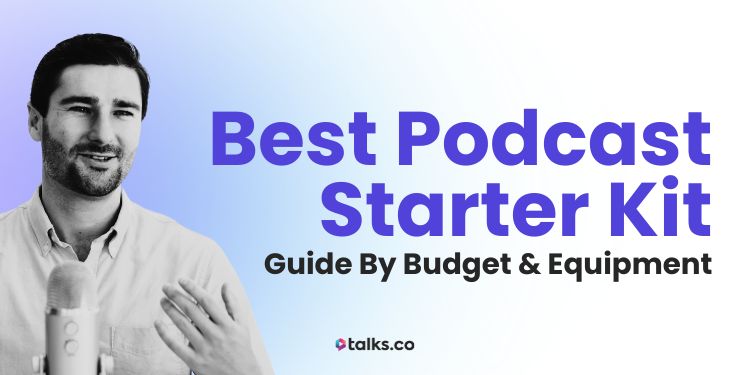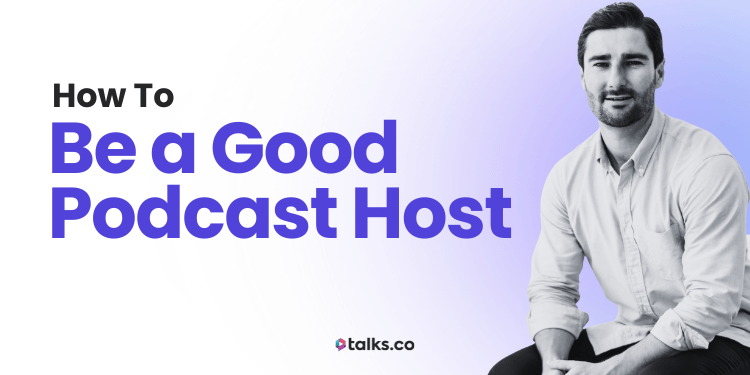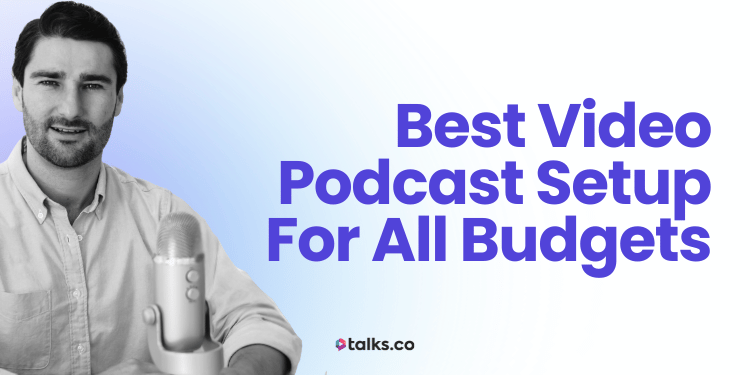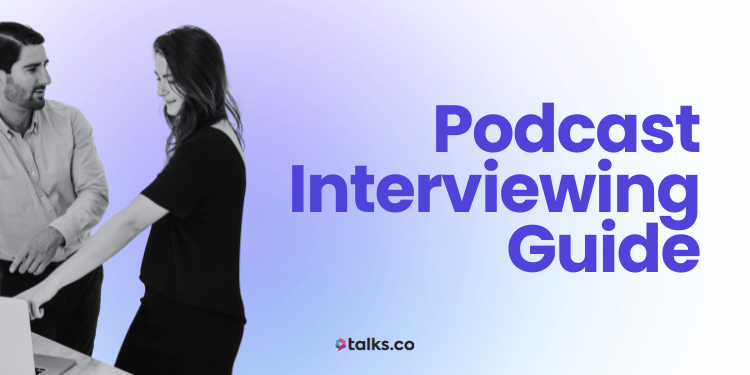What if you could start a podcast this week with gear that’s simple, sounds great, and doesn’t cost a fortune?
You’ve got something to say. You’ve got stories, lessons, ideas worth sharing. And now you’re asking the right question: What do I actually need to get this podcast off the ground?
When I recorded my first interviews back in 2015, I kept things pretty simple: Zoom, a Blue Yeti mic, a basic Logitech webcam, and some decent lighting. That setup helped me get my first episodes out there, and I’ve been podcasting ever since. No studio. No fancy team. Just a clear message and my podcast starter kit that helped me show up well.
So, take my word for it when I tell you: you don’t need much to start your podcast.
But having the right equipment bundle makes things smoother and gives you the confidence to focus on your message instead of stressing over tech.
In this guide, I’ll walk you through everything you need to launch your podcast the smart way. Easy-to-use podcast equipment bundles. Budget-friendly options for podcasters.
Let’s get you set up and ready to record a podcast.
Best Podcast Starter Kit
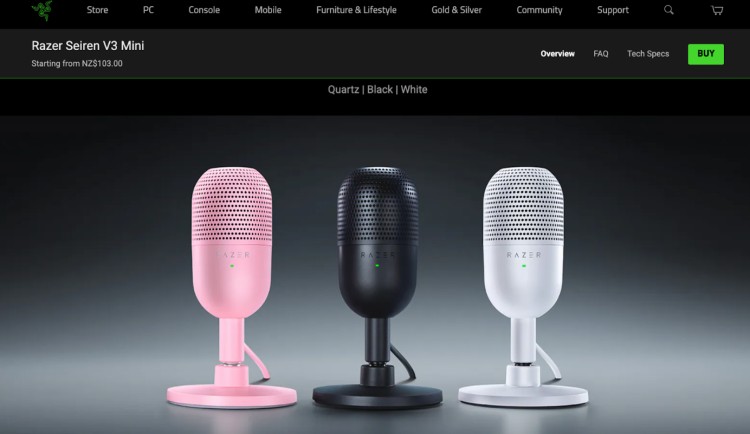
When you first step onto the pitch you don’t buy pro-level boots; you grab the boots that match your budget and the surface you’re playing on. Same goes for the ultimate podcast starter gear.
Pick one of these three starter kits based on the equipment you’ll need and you’ll sound sharp from episode one without paying for podcast setup features you’ll never touch.
Entry-level bundle: $93.99
- Razer Seiren V3 Mini USB microphone: $61.06
- Monoprice 8323 over-ear headphones: $22.94
- Ocenaudio editing software: Free
- InnoGear dual-layer pop filter: $9.99
Mid-tier bundle: $377.79
- Rode PodMic dynamic XLR microphone: $99
- Behringer UMC22 audio interface: $40.90
- Sennheiser HD280 Pro studio headphones: $99.95
- Foam Souls twelve-pack acoustic wedges: $39.99
- On-Stage MBS7500 boom arm: $97.95
Pro-level bundle: $2,980.98
- Electro-Voice RE20 broadcast microphone: $449
- PreSonus Revelator io24 interface: $135
- BenQ PD2705U 4K monitor: $549.99
- Godox SL60W LED light kit: $199
- Sony ZV-E10 4K camera with capture card: $698
- Auralex Project 2 Roominator sound-treatment kit: $949.99 (full pack)
Choose the tier that fits your current needs. You can always sub in new pieces once the show starts paying for itself.
What Do I Need to Start a Podcast at Home?
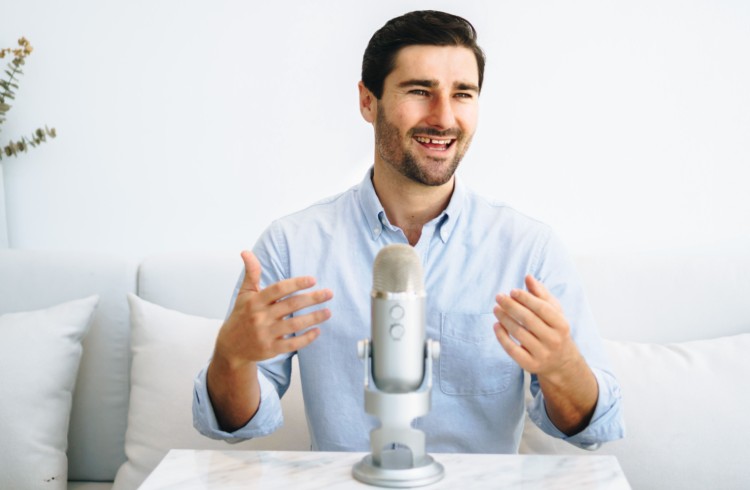
You can sound clear enough for your first episodes without shelling out more than you would on a decent dinner. Grab the everyday items below, add one budget microphone, and you are on-air for under $100.
- Tonor TC-777 USB microphone: $34.99. A plug-and-play mic that boosts your voice quality far above a laptop mic without draining your wallet.
- JLab Go Air Pop earbuds: $23.62. Lightweight in-ear monitors that let you catch pops, clicks, and background hiss while you record.
- GarageBand app: $0.00. A free Mac recording tool that gives you multi-track editing, fade automation, and built-in EQ presets.
- Old cushion or firm pillow: $0.00. Place it behind the mic to soak up early reflections and tame room echo.
- Spare duvet hung over a wardrobe door: $0.00. Works as an instant sound blanket, stopping hard-wall slapback that muddies vocals.
- Medium cardboard box lined with coffee-tray foam: $0.00. Cut out one side, point the mic into it, and you have a DIY reflection filter that tightens your sound.
- Smartphone voice-memo app: $0.00. Record a parallel backup track in case your computer glitches mid-session.
Total cost: $58.61
Is It Easy to Start a Podcast?
It’s as easy as hitting record and publishing a file, provided you follow a clear game plan. The checklist below keeps you moving so tech jitters don’t stall your launch.
Starting a podcast checklist
Before you hit record, it pays to get your foundation right. This pre-production checklist helps you clarify your concept, prep your gear, and set yourself up for a smooth podcast launch.
- Clarify your listener and the promise: Write one sentence that answers “Who am I talking to and what will they get every episode?”
- Set a realistic release cadence: Weekly or every other week is plenty. Consistency beats volume.
- Choose a show format: Solo teaching, interviews, co-host chat, or a mix. Pick one to start so listeners know what to expect.
- Outline your first five episode topics: A mini series gives you momentum and avoids staring at a blank page each week.
- Draft a repeatable episode structure: Intro, main content, recap, call-to-action. Keep segments short so editing is simpler.
- Select your gear: Reference the entry-, mid-, or pro-level kit lists and buy only what fits your space and budget now.
- Create a podcast title, tagline, and 3000×3000px cover art: Aim for clear, searchable wording and a bright image that pops at thumbnail size.
- Reserve show socials and domain: Even if you do not build a site yet, lock down the handles so no one else nabs them.
- Install recording software: Use Waveform Free (cross-platform) or GarageBand on Mac; set the project template to 48 kHz.
- Sound-treat your space: Rug on the floor, blanket on a hard wall, pillows in corners, or a twelve-pack of foam panels for $12.59.
- Run a 30-second test: Check that peaks sit between -12 dB and -6 dB and that no hum, hiss, or echo sneaks through.
- Write a one-paragraph show description: You will paste this into hosting platforms later, but drafting it now sharpens your focus.
Tick these twelve prep steps and you will be ready to record and publish without scrambling for artwork, gear, or a show outline at the last minute.
How to Get Started With a Podcast
Starting a podcast doesn’t mean you need a full studio on day one. The key is picking the kit that fits the number of mics you need, plug in, and follow the checklist to publish your first episode.
Podcast starter kit for beginners
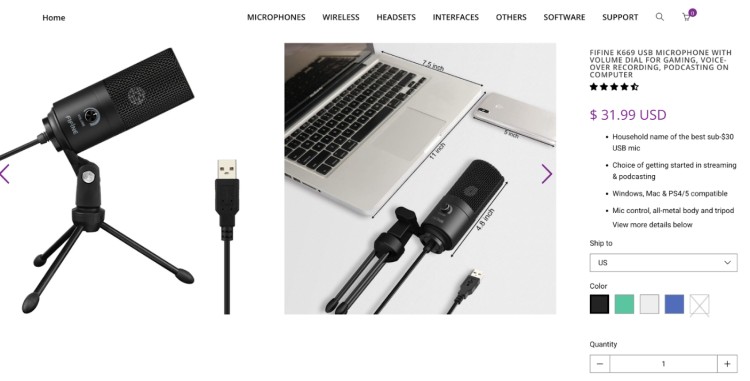
If you’re just testing the waters and want to keep costs low, here’s an easy to use cheap podcast setup that gets the job done under $100 total.
- Fifine K669B USB condenser microphone ($31.99): Plug-and-play, cardioid pickup, and surprisingly clean sound for the price. Just connect it via USB and you’re ready.
- OneOdio Pro-10 wired headphones ($39.99): Closed-back, comfortable, and solid for basic monitoring.
- Audacity (free recording software): Lightweight, open-source, and works on Mac, Windows, or Linux. Great for beginners.
- Foam pop filter + basic tripod mic stand ($19.64): Keeps plosives down and your mic steady. You can also use a stack of books in a pinch.
Total: $91.62
This podcast equipment starter kit combo won’t win any recording studio awards, but it’ll give you clear audio quality and build your content without delay or overspending.
Once you’ve got a few episodes under your belt, you’ll have a better feel for what’s worth upgrading next.
Best podcast starter kit for 2
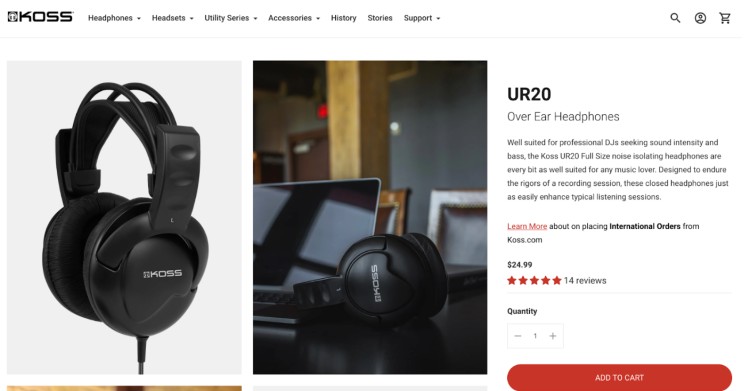
If you’re sharing the mic with a co-host or in-person guest, this setup stays under $250 and gives each voice a clean, separate channel.
- 2x Samson Q2U dynamic USB/XLR microphones ($79.99 each). Hybrid connectivity lets you plug straight into a laptop now and upgrade to an interface later.
- 2x Koss UR20 over-ear headphones ($24.99 each). Closed-back cups keep sound from leaking into the mics and stay comfy for longer chats.
- Ocenaudio recording software (free). Lightweight, cross-platform editor with real-time effects. Ideal substitute for Audacity in case you’re not a fan of the interface.
- Amazon Basics USB 3.0 powered hub ($29.99). Handy if your laptop has only one or two ports and you need both mics connected at once.
Total: $239.95
This two-person kit is plug-and-play, travels well, and leaves room in the budget if you want boom arms or decorative mic flags down the road.
Podcast starter kit for 3
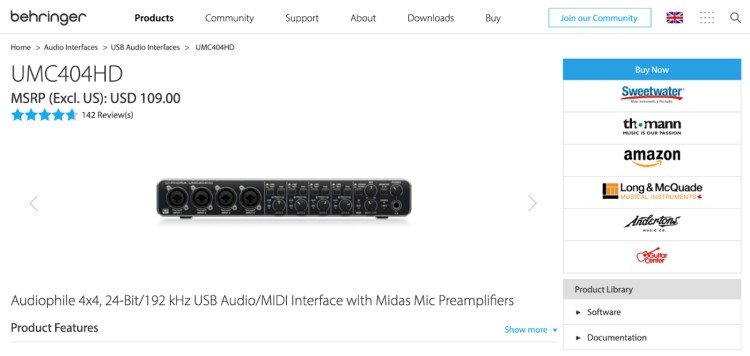
If you’ve got a three-person show with co-hosts or guests, you’ll need gear that keeps each mic clear and separate. Here’s a reliable setup:
- Behringer UMC404HD 4-input audio interface ($109): Four combo XLR inputs with individual gain controls and zero-latency monitoring.
- 3x Behringer XM8500 dynamic XLR microphones ($13.90 each): Durable, tight cardioid pickup to cut background noise.
- 3x Tascam TH-02 closed-back headphones ($19.99 each): Comfortable and decent isolation for basic monitoring.
- Reaper recording software (free trial, $60 discounted license): Full-featured podcast recording software that works well for multi-track editing.
Total: $270.67
This setup gives you clean audio and individual control over each voice, perfect for group shows without jumping into expert-level pricing.
Podcast starter kit for 4
Running a four-person show with guests or a panel? You’ll need a setup that can handle four mics without a complicated mixer. Here’s what works for a 4-person podcast setup:
- Zoom PodTrak P4 portable recorder ($169.99): Four XLR mic inputs, headphone outputs for each person, and onboard SD card recording. No laptop required.
- 4x Pyle PDMIC78 dynamic XLR microphones ($22.99 each): Budget mics that handle quiet indoor spaces well.
- 4x LyxPro HAS-10 studio headphones ($39.99 each): Clean sound and closed-back design for good monitoring.
- Hindenburg Lite (free version): Easy-to-use podcast editing software made for spoken audio.
Total: $421.91
This setup keeps things mobile and organized while giving each speaker a clean audio feed. Great for group podcasts without needing a full studio build.
Items Needed to Start a Podcast
Every successful show boils down to a clear voice, clean monitoring, and reliable recording. Grab the essentials below and you’re set.
Video podcast starter kit
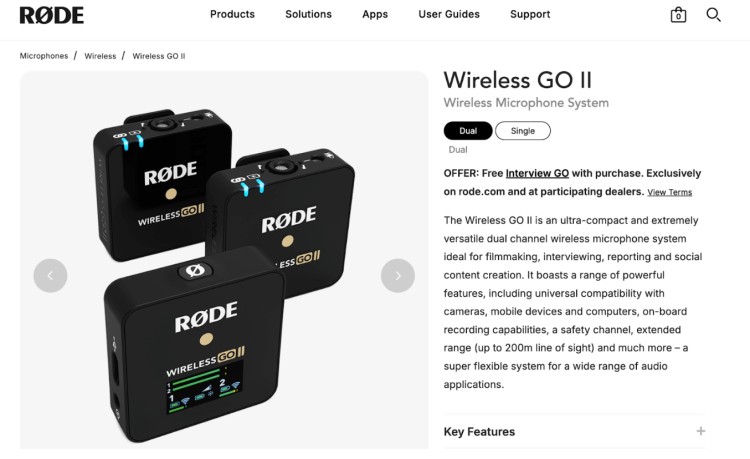
If you’re recording and editing your podcast for social media clips or streaming to YouTube, add audio and video podcasting ready gear that travels well.
- RODE Wireless GO II dual-channel mic system ($254.98). Two clip-on transmitters and a receiver give you cable-free audio up to 200 meters.
- Logitech Brio 4K webcam ($169.99). Crisp picture, easy USB setup, automatic light adjustment.
- Neewer 660 LED panel kit ($161.58). Two dimmable lights with stands brighten faces and kill shadows.
- SmallRig tabletop tripod ($39.99). Keeps the webcam steady without hogging desk space.
Podcast equipment starter kit
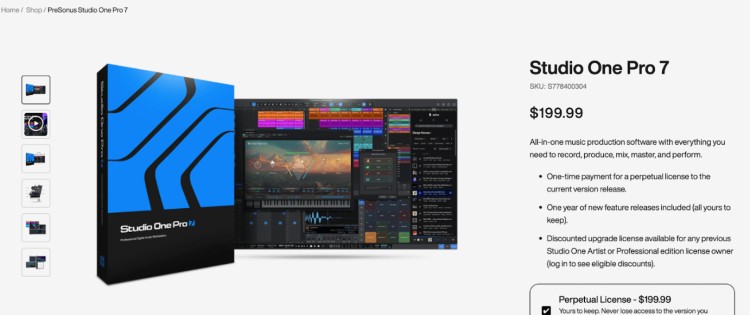
Need an all-around pack that works straight out of the case? Go for a balanced USB bundle.
- Pyle USB podcast kit ($64.99). Condenser mic, pop filter, desktop stand, USB cable, and hard case in one package.
- AKG K92 headphones ($79). Closed-back headphones that block out background noise so you can focus on clean, accurate edits
- Studio One Pro 7 editing software ($199.99). Podcast-specific editor with auto-leveling and a simple layout for fast clean-ups. For under $200, it’s yours to keep.
What equipment I need to start a podcast?
If you’d rather build your setup piece by piece instead of a podcast equipment bundle, here’s a bare-bones list that covers the essentials.
- One solid dynamic microphone. Find one that matches your voice and cuts background noise.
- Closed-back headphones. So you can monitor your audio without sound leaking into the mic.
- Laptop: A reliable computer is key for running recording software and editing. Here’s our guide to choosing the best laptop for podcasting depending on your needs and budget.
- Boom arm or desktop mic stand. Keeps your mic steady and at mouth level.
- Recording software. Choose TwistedWave (free online) or Studio One Artist (paid) to record, trim, and export MP3.
- Basic podcast room setup and treatment. A rug, cushions, or a few foam tiles can help reduce echo and reverb.
- A podcast hosting platform. This is where your audio files live. It generates your RSS feed and distributes your episodes to Apple Podcasts, Spotify, and other directories.
Start with the basics, match your setup to how many people you’re recording with, and focus on getting your message out. Everything else can be upgraded later.
Podcast Starter Pack Meme
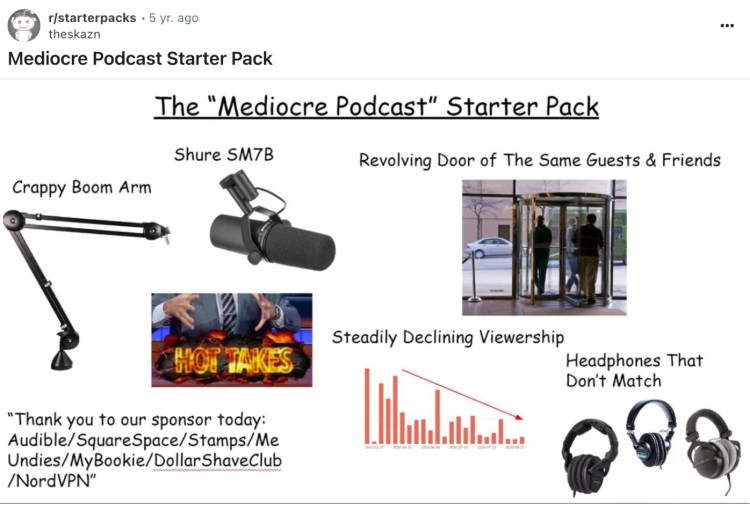
Want a visual breakdown of what you actually need to start podcasting? Think of the classic “starter pack” meme but instead of mediocre, make it podcast-ready.
The realistic podcast starter pack includes:
- A USB or dynamic mic (sorry, your laptop mic isn’t recommended)
- Headphones (to avoid echo and monitor your audio)
- Recording/editing software (Spotify for Creators keeps it simple and free)
- A quiet room (pillows and rugs do wonders)
- A podcast hosting platform (to push episodes to Podbean or Captivate)
Forget neon lights and $500 setups. You don’t need to look like a streaming gamer or Joe Rogan. Just the basics that get the job done clearly and consistently.
What to Buy to Start a Podcast
Feeling more confident and ready to launch your podcast? Here’s what to actually spend money on when you’re just getting started. You can explore the full breakdown of how much it costs to start a podcast here.
Poppy Podcast starter kit vs XO Poppy podcast starter kit
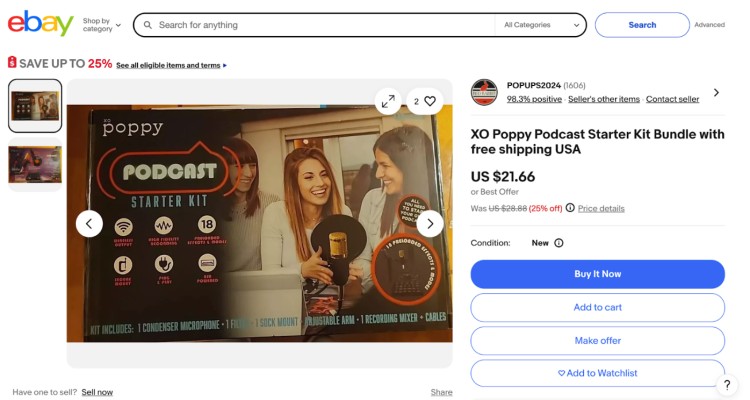
You’ll see both the Poppy Podcast Starter Kit and the XO Poppy Podcast Starter Kit mentioned online, but most of the listings point to the XO version. So, if you’re seeing both names, you’re likely looking at the same product.
The XO Poppy Podcast Starter Kit is a secondhand favorite floating around eBay. This ultra-budget kit includes:
- Condenser mic: Compact and decent for casual voice recording
- Pop filter: Cuts out harsh plosives
- Adjustable arm stand: Clamps to most desks
- Sound mixer: Volume controls, echo effects, 18 preloaded sound effects
- Cables: USB and 3.5mm options for flexible connection
Don’t expect studio sound quality results, but for quick tests or practice runs, it’s a handy little kit to have around. If you’re looking for an ultra-low-cost starter pack, this one checks the boxes.
Podcast starter kit Amazon
Need everything in one click and on your doorstep tomorrow? These three Amazon bundles cover solo, duo, and multi-input needs all for under $150.
1. ALPOWL Audio Interface Bundle for 2
Price: $63.99
Good for: Two-person shows with plug-and-play simplicity
Includes:
- 2x BM-800 condenser microphones
- V8 live sound card
- 2x Scissor arm stands
- 2x Shock mounts
- 2x Pop filters
- Monitoring earphones
- Bluetooth connectivity
USB support for Mac, Windows, mobile
2. Tenlamp Podcast Microphone Bundle
Price: $69.99 (Prime price)
Good for: Quick laptop or phone setups with built-in effects
Includes:
- 3.5mm condenser mic
- Battery-powered 2-channel mixer
- Live sound board with voice changer
- 24 sound effects (applause, echo, etc.)
- Desk stand
- All required cables
3. MaonoCaster Lite AU-AM200-S1 Studio Bundle
Price: $101.23 (Prime price)
Good for: More control and effects for podcasting or live streaming
Includes:
- 3.5mm condenser microphone
- 9-channel audio mixer with real-time effects
- Tripod stand
- Windscreen
- Dual TRRS cables
- Supports 2 mics and up to 4 devices
Podcast starter pack
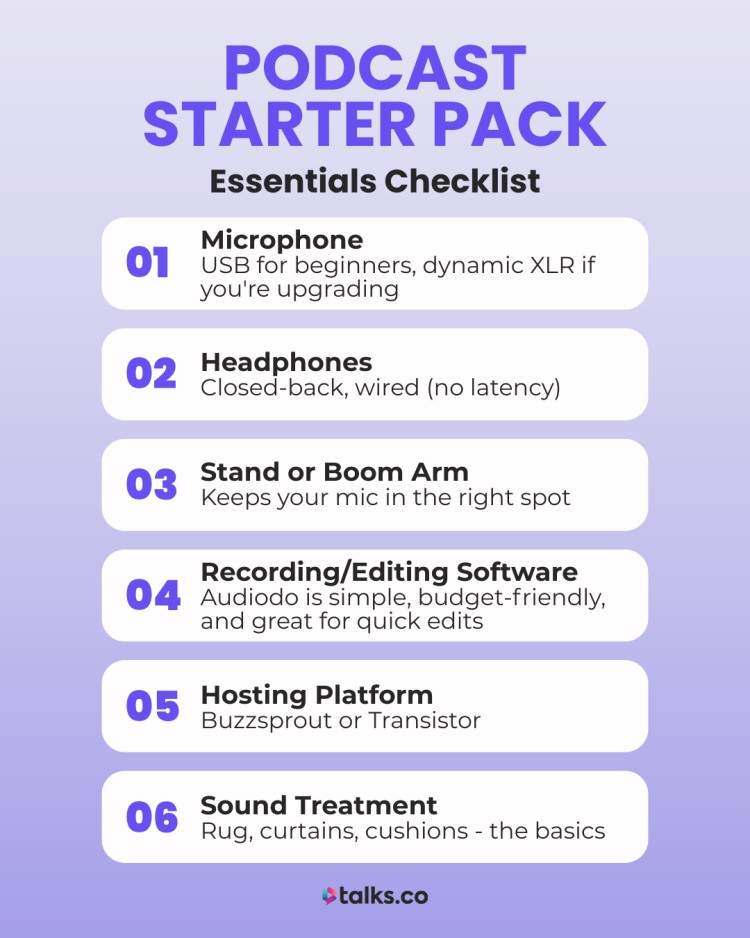
Here’s a minimalist podcast starter pack checklist that works for any format from solo or co-hosted to guest-based.
Essentials checklist:
- Microphone: USB for beginners, dynamic XLR if you’re upgrading
- Headphones: Closed-back, wired (no latency)
- Stand or boom arm: Keeps your mic in the right spot
- Recording/editing software: Audiodo is simple, budget-friendly, and great for quick edits. Check this out in case you’re recording a podcast remotely for more tips.
- Hosting platform: Buzzsprout or Transistor
- Sound treatment: Rug, curtains, cushions – the basics
Keep it simple. The right starter pack’s only mission is to get your message out immediately, clearly, and consistently.
Sound, Then Crowd
You’ve got the gear. You’ve got the message. Now you need listeners. Your podcast starter kit sets you up to sound great. Talks gets you heard.
Why pitch yourself with endless “Can I be on your show?” emails when hosts are already looking for experts like you?
Create your free Talks creator profile and let the matching engine do the heavy lifting.
